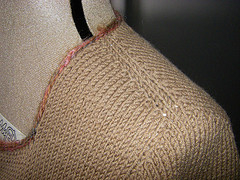-–убрики
- улинари€ (789)
- —ладка€ выпечка (209)
- «акусочна€ выпечка (131)
- —алаты и закуски (90)
- ѕрочее (81)
- ћ€со (70)
- «аготовки (65)
- ƒесерты (43)
- –ыба (37)
- ќвощи (37)
- ѕервые блюда (12)
- —пицы (237)
- Ўкола в€зани€ (104)
- ƒл€ женщин (96)
- ƒл€ мужчин (24)
- ƒет€м (11)
- ƒл€ дома (2)
- рючок (106)
- ∆енщинам (21)
- ќбразцы узоров (18)
- Ўкола в€зани€ (14)
- ƒл€ дома (8)
- ƒл€ детей (1)
- ћужчинам (1)
- расота и здоровье (86)
- ѕрочие рукодели€ (32)
- »нтересно (18)
- »деи дл€ дома (14)
- ƒача (11)
-ћузыка
- Chris Rea- The blue cafe
- —лушали: 82128 омментарии: 0
- –ольф Ћовланд. ѕлач ќ Ћюбви. —екретный —ад
- —лушали: 3105 омментарии: 0
- Garou
- —лушали: 166 омментарии: 0
- –ичард лайдерман - Ѕрак по любви
- —лушали: 418 омментарии: 0
- Lizz Wright - Hit The Ground
- —лушали: 2223 омментарии: 0
-ѕоиск по дневнику
-ѕодписка по e-mail
-»нтересы
-ѕосто€нные читатели
-—татистика
»ммитаци€ вшивного рукава. |
÷итата сообщени€ Ћюмли€
»ммитаци€ вшивного рукава
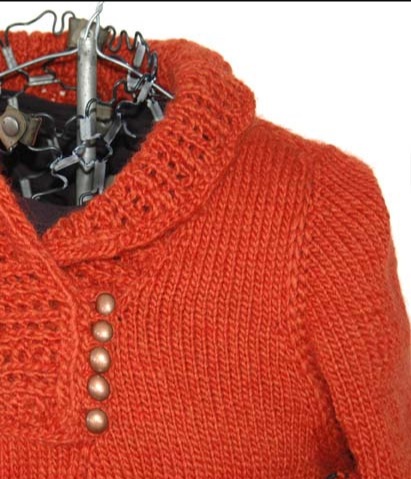
ќчень несложный в освоении и увлекательный метод бесшовного в€зани€ издели€ с втачным рукавом Contiguous, предложенный Susie Myers( SusieM on Ravelry)
јвтор из јвстралии делитс€ своей находкой бескорыстно, но просит не забывать упом€нуть, что изделие св€зано именно по предложенному ей методуContiguous
ƒевиз таков: "The method is free; if I can’t get rich, maybe I can get famous! ;-)" Ётот метод распростран€етс€ бесплатно; раз уж € не могу разбогатеть, то может быть смогу прославитьс€:))
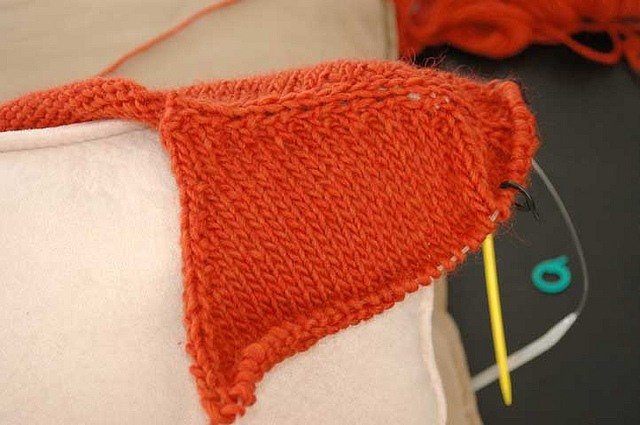
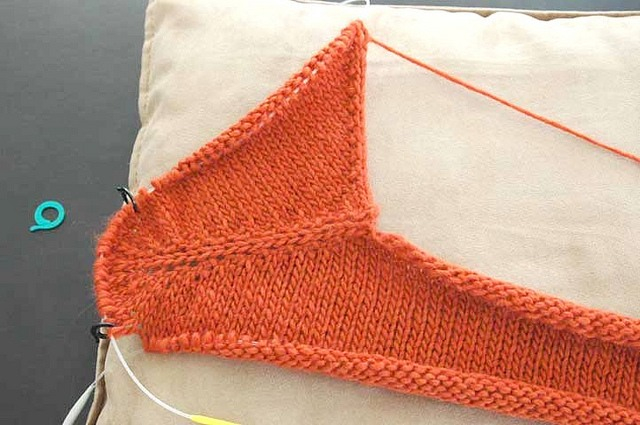
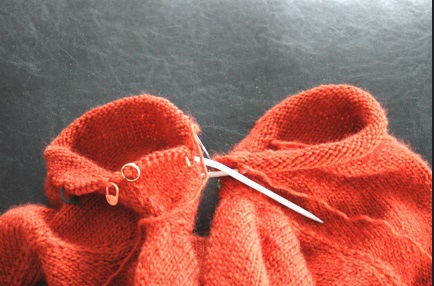

описание на английском с сайта Ravelry:
QUOTE
he summary –
for the shoulder: for every row, increase either side of two centre stitches, for each shoulder (4 increases every row)
for sleeve cap: increase every row, on the sleeve side of markers. (4 increases every row)
for stopping the neck rising too high: increases along the back neck (2, 3 or 4 every second row for 6 - 8 rows)
In more detail:
This is the method, not a pattern. You still have to do shaping for front neck openings, joining up to knit in the round when you’re ready to, separating sleeves from body, etc
The back neck increases are not written in, as their placement is variable, depending on whether you do 2, 3 or 4.
pm = place marker
sm = slip marker
& = unspecified/unknown number of stitches (depends on you)
Use the cast-on of your choice. I use a knitted cast-on most of the time. You may wish to do the back neck sts as a provisional cast-on if your pattern has ”pick-up sts” for a collar.
Cast on stitches for back neck (work this out as distance x gauge)
Cast on 6 more sts.
Row 1: k1, pm, k2, pm, k to last three sts, pm, k2, pm, k1
Row 2: pfb~, sm, p2, sm, pfb, purl to 1 st before marker, pfb, sm, p2, sm, pfb
Row 3: k1, kfb~, sm, k2, sm, kfb, k to 1 st before marker, kfb, sm, k2, sm, kfb, k1
~ = or any increase of your choice
continue in this manner, doing an increase either side of the marker EVERY row, until the ”seam” is the length of your shoulder.
You can work out how many rows you may need to do for this shoulder seam by distance x row gauge. The type of increase you use may cause this seam to tighten a bit, so you may need to do a couple more rows; or, remember to do the increases + centre sts loosely.
That’s the shoulder part done. It forms a good slope for shoulders without having to do short rows
For the sleeve:
Now move the markers so there are 6 sts between markers. These are now the top of the sleeve cap. You will be increasing ONLY between the markers which mark off the sleeve stitches.
Next Row: K&, sm, kfb, k4, kfb,(8 sts), sm, k&, sm, , kfb, k4, kfb, (8 sts), sm, k&
Next Row: P&, sm, pfb, p6, pfb (10 sts), sm, p&, sm, pfb, p6, pfb (10 sts), sm, p&
Next Row: K&, sm, kfb, k8, kfb (12 sts), sm, k&, sm, kfb, k8, kfb (12 sts), sm, k&
etc.
continue in this manner for several rows, increasing EVERY row, on the sleeve side only of the markers.
Do this for only a few rows!
Do NOT do this for the whole armscye!
My guess is this would only need to be done for the same distance down as BW’s short rows to shape the sleeve cap (approx one-sixth of the armhole depth, either side of the shoulder seam, as measured down from that shoulder seam)
Then do the increases every second row (knit row)
and continue all the rest of the pattern elements too, just as you would for a BW top-down design.
If you use the method to knit or develop a garment, or write a pattern, would you please include the following acknowledgement:
This garment is worked seamlessly from the top-down using the contiguous sleeve method developed by Susie Myers
for the shoulder: for every row, increase either side of two centre stitches, for each shoulder (4 increases every row)
for sleeve cap: increase every row, on the sleeve side of markers. (4 increases every row)
for stopping the neck rising too high: increases along the back neck (2, 3 or 4 every second row for 6 - 8 rows)
In more detail:
This is the method, not a pattern. You still have to do shaping for front neck openings, joining up to knit in the round when you’re ready to, separating sleeves from body, etc
The back neck increases are not written in, as their placement is variable, depending on whether you do 2, 3 or 4.
pm = place marker
sm = slip marker
& = unspecified/unknown number of stitches (depends on you)
Use the cast-on of your choice. I use a knitted cast-on most of the time. You may wish to do the back neck sts as a provisional cast-on if your pattern has ”pick-up sts” for a collar.
Cast on stitches for back neck (work this out as distance x gauge)
Cast on 6 more sts.
Row 1: k1, pm, k2, pm, k to last three sts, pm, k2, pm, k1
Row 2: pfb~, sm, p2, sm, pfb, purl to 1 st before marker, pfb, sm, p2, sm, pfb
Row 3: k1, kfb~, sm, k2, sm, kfb, k to 1 st before marker, kfb, sm, k2, sm, kfb, k1
~ = or any increase of your choice
continue in this manner, doing an increase either side of the marker EVERY row, until the ”seam” is the length of your shoulder.
You can work out how many rows you may need to do for this shoulder seam by distance x row gauge. The type of increase you use may cause this seam to tighten a bit, so you may need to do a couple more rows; or, remember to do the increases + centre sts loosely.
That’s the shoulder part done. It forms a good slope for shoulders without having to do short rows
For the sleeve:
Now move the markers so there are 6 sts between markers. These are now the top of the sleeve cap. You will be increasing ONLY between the markers which mark off the sleeve stitches.
Next Row: K&, sm, kfb, k4, kfb,(8 sts), sm, k&, sm, , kfb, k4, kfb, (8 sts), sm, k&
Next Row: P&, sm, pfb, p6, pfb (10 sts), sm, p&, sm, pfb, p6, pfb (10 sts), sm, p&
Next Row: K&, sm, kfb, k8, kfb (12 sts), sm, k&, sm, kfb, k8, kfb (12 sts), sm, k&
etc.
continue in this manner for several rows, increasing EVERY row, on the sleeve side only of the markers.
Do this for only a few rows!
Do NOT do this for the whole armscye!
My guess is this would only need to be done for the same distance down as BW’s short rows to shape the sleeve cap (approx one-sixth of the armhole depth, either side of the shoulder seam, as measured down from that shoulder seam)
Then do the increases every second row (knit row)
and continue all the rest of the pattern elements too, just as you would for a BW top-down design.
If you use the method to knit or develop a garment, or write a pattern, would you please include the following acknowledgement:
This garment is worked seamlessly from the top-down using the contiguous sleeve method developed by Susie Myers
ѕеревод описани€:
јвтор предупреждает, что это - именно метод выв€зывани€, а не готова€ выкройка, поэтому мы сами должны рассчитать по желаемой модели количество петель, способ формировани€ выреза переда, глубину проймы, чтобы определитьс€, когда именно мы будем отдел€ть рукава и т.п. ћетод же определ€ет ритм выв€зывани€ плечевого скоса и рукавов единым полотном.
ќбща€ иде€ состоит в том, что в€зание начинаетс€ от горловины спинки издели€. «на€ плотность в€зани€, рассчитываетс€ нужное количество петель, к этому числу прибавл€етс€ еще шесть, и все они набираютс€ любым удобным дл€ нас способом. ¬ первом р€ду надо разместить четыре маркера (ћ), вдоль которых будем набирать дополнительные петли плечевого скоса. ƒл€ формировани€ плеча петли добавл€ютс€ в каждом р€ду. —хема така€:
р€д 1: 1лиц, ћ, 2лиц, ћ, все лиц до последних трех, ћ, 2лиц, ћ, 1лиц
р€д 2: изн за переднюю и заднюю стенку , ћ, 2изн, ћ, изн за переднюю и заднюю стенку, все изн до 1 последней петли перед маркером, изн за переднюю и заднюю стенку, ћ, 2изн, ћ, изн за переднюю и заднюю стенку
р€д 3: лиц, лиц за переднюю и заднюю стенку, ћ, 2 лиц, ћ, лиц за переднюю и заднюю стенку, все лиц до 1 последней петли перед маркером, лиц за переднюю и заднюю стенку, ћ, 2лиц, ћ, лиц за переднюю и заднюю стенку, лиц
добавл€ть петли можно любым способом, а не только "за переднюю и заднюю стенку"
“аким образом продолжаем в€зание, пока не получим нужной нам длины плечевого "шва". ћожно рассчитать сколько р€дов нам понадобитс€, умножив длину плеча на плотность нашего в€зани€ в р€дах. ≈сли св€зав плечо по расчету оно окажетс€ коротковатым, то можно св€зать еще пару-тройку р€дов, чтобы компенсировать ст€нутость, однако в любом случае надо старатьс€ пров€зывать центральные петли "шва" и дополнительные петли по-свободнее.
ѕереходим к выв€зыванию рукава. Ќадо перенести маркеры, выделив шесть петель дл€ верхушки рукава, теперь прибавки будем делать вдоль маркеров только со стороны рукава. ѕричем надо определитьс€ с общей глубиной проймы дл€ издели€, потому что где-то дл€ 1/6 этой величины мы будем прибавл€ть петли в каждом р€ду ( дл€ круглой головки рукава), а потом будем делать прибавки через р€д, таким образом набира€ нужную ширину рукава и формирую красивый "шов" вдоль "проймы" . —хема така€:
след.р€д : лиц&, ћ, лиц за переднюю и заднюю стенку, 4 лиц, лиц за переднюю и заднюю стенку,(8 петель), ћ, лиц&, ћ, , лиц за переднюю и заднюю стенку, лиц 4, лиц за переднюю и заднюю стенку, (8 петель), ћ, лиц&
след.р€д: изн&, ћ, изн за переднюю и заднюю стенку, 6 изн, изн за переднюю и заднюю стенку (10 петель), ћ, изн&, ћ, изн за переднюю и заднюю стенку, 6 изн, изн за переднюю и заднюю стенку (10 петель), ћ, изн&
след.р€д: лиц&, ћ, лиц за переднюю и заднюю стенку, 8 лиц, лиц за переднюю и заднюю стенку,(12 петель), ћ, лиц&, ћ, , лиц за переднюю и заднюю стенку, лиц 8, лиц за переднюю и заднюю стенку, (12 петель), ћ, лиц&
и т.д.
& - любое необходимое количество петель
“акова схема в€зани€ именно плеча и рукава, остальные детали дл€ своей модели надо рассчитывать и выполн€ть как обычно, ну разве что вкруговую:))

ќбща€ иде€ состоит в том, что в€зание начинаетс€ от горловины спинки издели€. «на€ плотность в€зани€, рассчитываетс€ нужное количество петель, к этому числу прибавл€етс€ еще шесть, и все они набираютс€ любым удобным дл€ нас способом. ¬ первом р€ду надо разместить четыре маркера (ћ), вдоль которых будем набирать дополнительные петли плечевого скоса. ƒл€ формировани€ плеча петли добавл€ютс€ в каждом р€ду. —хема така€:
р€д 1: 1лиц, ћ, 2лиц, ћ, все лиц до последних трех, ћ, 2лиц, ћ, 1лиц
р€д 2: изн за переднюю и заднюю стенку , ћ, 2изн, ћ, изн за переднюю и заднюю стенку, все изн до 1 последней петли перед маркером, изн за переднюю и заднюю стенку, ћ, 2изн, ћ, изн за переднюю и заднюю стенку
р€д 3: лиц, лиц за переднюю и заднюю стенку, ћ, 2 лиц, ћ, лиц за переднюю и заднюю стенку, все лиц до 1 последней петли перед маркером, лиц за переднюю и заднюю стенку, ћ, 2лиц, ћ, лиц за переднюю и заднюю стенку, лиц
добавл€ть петли можно любым способом, а не только "за переднюю и заднюю стенку"
“аким образом продолжаем в€зание, пока не получим нужной нам длины плечевого "шва". ћожно рассчитать сколько р€дов нам понадобитс€, умножив длину плеча на плотность нашего в€зани€ в р€дах. ≈сли св€зав плечо по расчету оно окажетс€ коротковатым, то можно св€зать еще пару-тройку р€дов, чтобы компенсировать ст€нутость, однако в любом случае надо старатьс€ пров€зывать центральные петли "шва" и дополнительные петли по-свободнее.
ѕереходим к выв€зыванию рукава. Ќадо перенести маркеры, выделив шесть петель дл€ верхушки рукава, теперь прибавки будем делать вдоль маркеров только со стороны рукава. ѕричем надо определитьс€ с общей глубиной проймы дл€ издели€, потому что где-то дл€ 1/6 этой величины мы будем прибавл€ть петли в каждом р€ду ( дл€ круглой головки рукава), а потом будем делать прибавки через р€д, таким образом набира€ нужную ширину рукава и формирую красивый "шов" вдоль "проймы" . —хема така€:
след.р€д : лиц&, ћ, лиц за переднюю и заднюю стенку, 4 лиц, лиц за переднюю и заднюю стенку,(8 петель), ћ, лиц&, ћ, , лиц за переднюю и заднюю стенку, лиц 4, лиц за переднюю и заднюю стенку, (8 петель), ћ, лиц&
след.р€д: изн&, ћ, изн за переднюю и заднюю стенку, 6 изн, изн за переднюю и заднюю стенку (10 петель), ћ, изн&, ћ, изн за переднюю и заднюю стенку, 6 изн, изн за переднюю и заднюю стенку (10 петель), ћ, изн&
след.р€д: лиц&, ћ, лиц за переднюю и заднюю стенку, 8 лиц, лиц за переднюю и заднюю стенку,(12 петель), ћ, лиц&, ћ, , лиц за переднюю и заднюю стенку, лиц 8, лиц за переднюю и заднюю стенку, (12 петель), ћ, лиц&
и т.д.
& - любое необходимое количество петель
“акова схема в€зани€ именно плеча и рукава, остальные детали дл€ своей модели надо рассчитывать и выполн€ть как обычно, ну разве что вкруговую:))

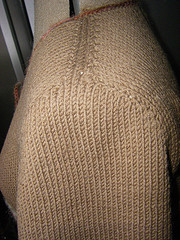

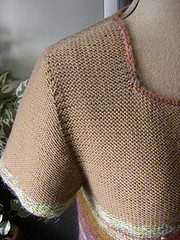
| –убрики: | —пицы/Ўкола в€зани€ |
| омментировать | « ѕред. запись — дневнику — —лед. запись » | —траницы: [1] [Ќовые] |
